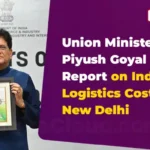
New Delhi:
On the occasion of the Make in India decade celebrations, Union Minister of Commerce and Industry, Shri Piyush Goyal, launched the report on Assessment of Logistics Cost in India in New Delhi on 20 September 2025. For the first time, India has a scientifically derived and comprehensive estimate of logistics costs, prepared using a hybrid approach combining secondary data with nationwide surveys.
This initiative fulfills a mandate of the National Logistics Policy (2022) to establish a uniform measurement framework for logistics costs, enabling benchmarking against international standards.
https://drive.google.com/file/d/1w2Pyd2rzCiJ_GZijUxHZmoPuKdSqzgPc/view
Shri Goyal emphasized that reducing logistics costs has been a central government priority to enhance India’s global competitiveness and lower the cost of doing business. “Through coordinated reforms, infrastructure expansion, and data-driven planning, India is ensuring that logistics no longer remain a bottleneck but a driver of economic growth,” the minister stated.
Until now, India’s logistics costs were often quoted at 13–14% of GDP, figures largely drawn from external studies or partial datasets. The new assessment, prepared by the National Council of Applied Economic Research (NCAER) for DPIIT, establishes the figure at 7.97% of GDP, offering clarity for policymakers and international stakeholders.
The report provides a detailed framework by capturing logistics costs across transport modes, product categories, and firm sizes, and includes estimates of freight cost per tonne-kilometre. It highlights the role of multi-modal transport in cutting inefficiencies and strengthening supply chains.
Shri Goyal outlined several key government initiatives shaping India’s logistics sector:
- HSN code mapping to respective line ministries for smoother coordination.
- Integrated state and city logistics plans under the SMILE programme with ADB support.
- Expansion of transport infrastructure via NICDC-led projects, PM GatiShakti National Master Plan, Dedicated Freight Corridors, Bharatmala, Sagarmala, and Integrated Check Posts.
- Digital solutions like the Unified Logistics Interface Platform (ULIP) and the Logistics Efficiency Enhancement Programme (LEAP).
The report also notes a slowing growth rate of logistics costs relative to non-services output over the past five years, signaling efficiency gains from reforms such as GST, rationalization of freight structures, and increased multimodal connectivity.
By aligning logistics costs closer to global benchmarks, India is reinforcing its aspiration to become a world-class logistics hub, while offering businesses a more predictable and efficient operating environment.
